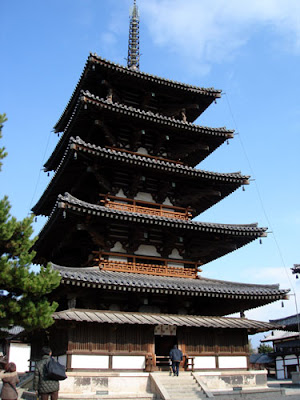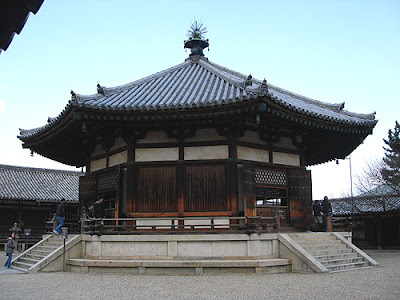Horyuji Temple Nara
16:47
法隆寺、奈良
Horyuji Temple, about 10km south west of Nara, contains the world's oldest surviving wooden buildings.
Founded, according to the wishes of his dying father, in 607 by Prince Shotoku, Horyuji is a UNESCO World Heritage site, the first to be so designated in Japan.

Horyuji ("Temple of the Flourishing Law") supposedly burnt down in 670 and was then rebuilt; the ancient wooden structures in the temple complex are thought to date to that time.
Most striking is the 32.5m-tall Five-Story Pagoda (Goju-no-to) - the oldest five-storied pagoda in Japan. Inside the building is a collection of clay statues from the Nara Period (710-794).

The Main Hall (Kondo) contains the main sacred statues of the temple. These priceless Buddhist images include a bronze Shaka Triad showing the historical Buddha and two bodhisattvas, dating from 623. To the right is the Yakushi Nyorai - the Buddha of Healing - to which the temple is dedicated. A 12th century Amida Buddha commemorates Prince Shotoku's mother.
The eastern precinct (Toin Garan) added in 739 contains the octagonal Hall of Visions (Yume-dono). This delightful, wooden building contains the Kuse Kannon (Avalokitesvara), said to be a life-size statue of Prince Shotoku.

Access
To reach Horyuji Temple, which is located in the Ikaruga district take a JR Yamatoji Line Osaka-bound train to Horyuji Station and then walk the 20 minutes to the temple of take a local #72 bus. Alternatively, take a bus from Nara to Horyuji-mae bus stop. Bicycles can be hired at the information near the bus stop on National Highway 25 at the entrance road to the temple.
© Japan Visitor.com
Yahoo Japan Auction Service
Book a Japanese Hotel with Bookings
Tokyo Serviced Apartments
Japanese Friends
The Japanese Spa: A Guide to Japan's Finest Ryokan and Onsen
Tags
Horyuji Temple Nara Japanese Buddhism
Horyuji Temple, about 10km south west of Nara, contains the world's oldest surviving wooden buildings.
Founded, according to the wishes of his dying father, in 607 by Prince Shotoku, Horyuji is a UNESCO World Heritage site, the first to be so designated in Japan.

Horyuji ("Temple of the Flourishing Law") supposedly burnt down in 670 and was then rebuilt; the ancient wooden structures in the temple complex are thought to date to that time.
Most striking is the 32.5m-tall Five-Story Pagoda (Goju-no-to) - the oldest five-storied pagoda in Japan. Inside the building is a collection of clay statues from the Nara Period (710-794).

The Main Hall (Kondo) contains the main sacred statues of the temple. These priceless Buddhist images include a bronze Shaka Triad showing the historical Buddha and two bodhisattvas, dating from 623. To the right is the Yakushi Nyorai - the Buddha of Healing - to which the temple is dedicated. A 12th century Amida Buddha commemorates Prince Shotoku's mother.
The eastern precinct (Toin Garan) added in 739 contains the octagonal Hall of Visions (Yume-dono). This delightful, wooden building contains the Kuse Kannon (Avalokitesvara), said to be a life-size statue of Prince Shotoku.

Access
To reach Horyuji Temple, which is located in the Ikaruga district take a JR Yamatoji Line Osaka-bound train to Horyuji Station and then walk the 20 minutes to the temple of take a local #72 bus. Alternatively, take a bus from Nara to Horyuji-mae bus stop. Bicycles can be hired at the information near the bus stop on National Highway 25 at the entrance road to the temple.
© Japan Visitor.com
Yahoo Japan Auction Service
Book a Japanese Hotel with Bookings
Tokyo Serviced Apartments
Japanese Friends
The Japanese Spa: A Guide to Japan's Finest Ryokan and Onsen
Tags
Horyuji Temple Nara Japanese Buddhism
コメントを投稿